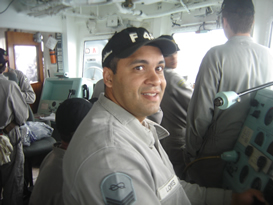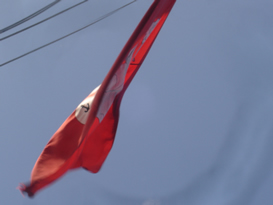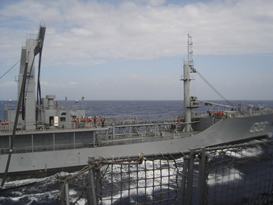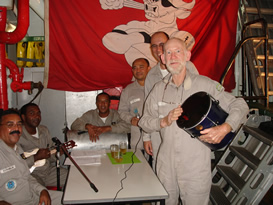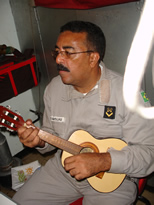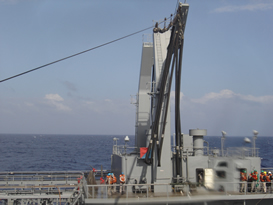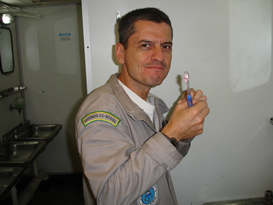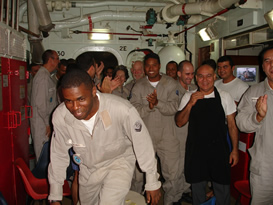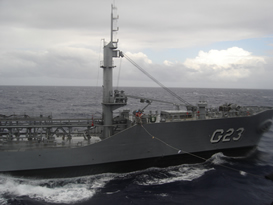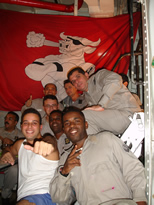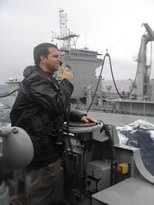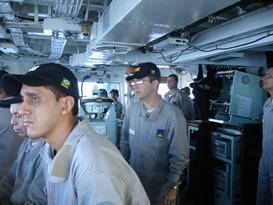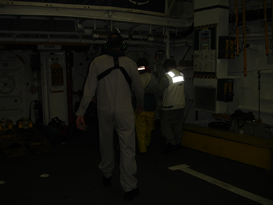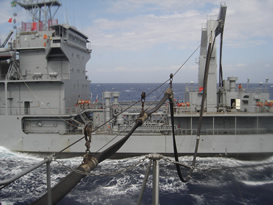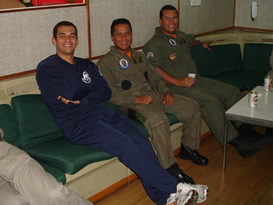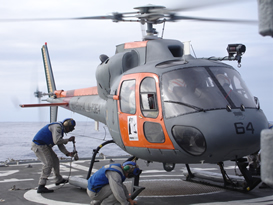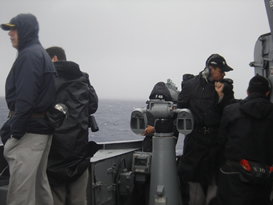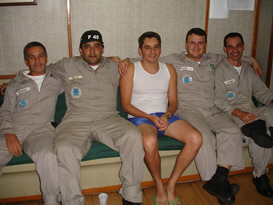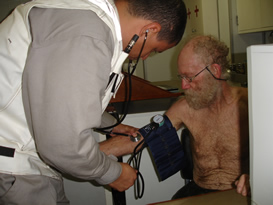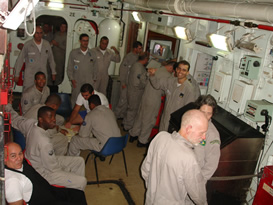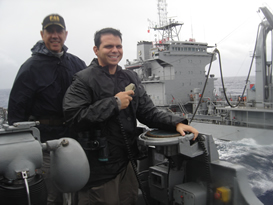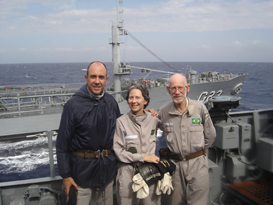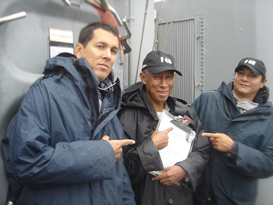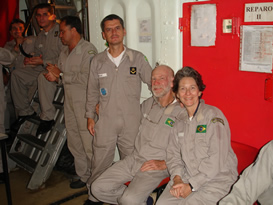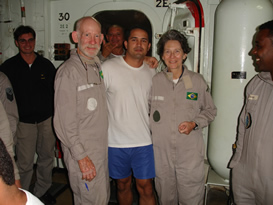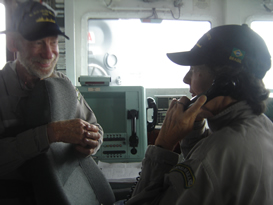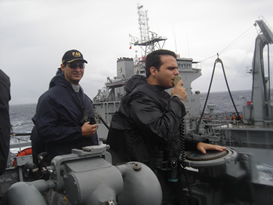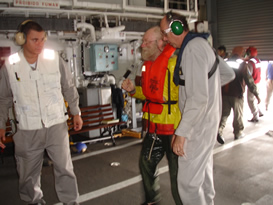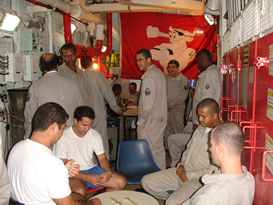A few days after ‘Carte Blanche’ sailed north, we lifted the anchor and moved to the large bay of Equimina. A satellite dish and exterior security lights on the outside of abandoned buildings and factories, the skeletal remains of a jetty, together with a line of palm trees indicate the residential area of the farm ashore. A mud, palm thatched village can be seen between the foliage and a disused church covered in red bougainvillea. The headlands that form the bay, continue inland as mountainous barriers towards the horizon, encompassing and sheltering the broad valley within.
The Pilot warns that the bottom shoals rapidly so we entered slowly and anchored in 3m, noticing the remains of 2 wrecks on the beach. The holding proved good, but we were more exposed to the wind, making it a rolly and uncomfortable anchorage. We were quite a distance offshore and were glad we could use the outboard on the dinghy. Jess went ashore for fresh water, with the children gathering curiously around trying to help; including one who had a tiny goat kid tucked under his arm, which J at first thought was a puppy. Raymond and Jess had visited the farm earlier and met Fernando the farmer, who invited us to visit, fill our water tanks and take a shower. It seems that Equimina has had various inhabitants over many years. It has been a slave station, wine farm, whaling station, a fish factory processing anchovies and fish oil; and during the Angolan civil war it was a concentration camp housing 1500 prisoners, mainly women. Today it is an expanding vegetable farm, whose main crops are tomatoes and onions, delivering weekly directly to Luanda. It is a 100 km drive to Benguela, the nearest town, by jeep or lorry over very bad gravel roads.
Fenando spends most of the day out on the lands, personally supervising and working with his laborers, drawn from the local village, but he was at home when Jess went ashore again the following day. Accepting an invitation to lunch, Heather too met Fernando and cousin Carlos, his right-hand. Freshly caught cuttlefish (choka) and home baked bread for lunch. They had to return to the lands to continue planting and we happily accepted an invitation to accompany them. We drove through a mixture of vegetation, part tropical, part bush-veld (sort of eastern Transvaal) in a very old Willy’s jeep with empty gun-racks between the sets. Some of the fields had had the crops picked and were waiting to be turned, other lay fallow, some were half grown and one was being planted with young seedlings. Fernando started clearing and planting in February last year 2003 and its amazing to see what he had accomplished in such a short time. They have one tractor, plough and harrower, but much is done by hand. He had to clear the area of bush and trees before planting, which revealed olive trees which he hopes will bear in the future. The climate is so good that he can reap 2, possibly 3 harvests per year! It has something to do with the valley being trapped between the mountains and the breezes off the sea. Irrigation is via furrows at the moment into beds which are laid out by hand so that that water can flow right through the crop – all labour intensive. He has 30 acres under cultivation and the distance around the farm is 25 kms. He has sunk several wells from which he pumps his “sweet water” and which we filled our tanks with. In the gully near the well, ducks swim and we saw a ‘little widower’ bird having a bath. This little black and white bird has an extremely long ribbon like tail – called little widower in Portuguese because it looks like its wearing a suit. There were lot of little birds twittering and flying above the fields, totally unafraid of the people below. There were also Bantam chickens scratching around the pump station, stalked by a young (and not pretty) kitten. Trees close to the well provide shade for the nursery seedlings, collected by the mostly women workers who carry them in basins for transplanting by hand. Fernando says they work a 3 hour morning shift and then because of the heat, follow the European habit of a late lunch and rest period, before returning in the afternoon and working into the cool of dusk. The valley is a garden of Eden. Fernando says he will turn it into a real garden, with rows of fruit trees and maybe even flowers – now I understand why they are called ‘market-gardens’! He evidently has a green thumb, is unafraid of hard work and we have no doubt that Equimina will be hard to recognize in the future.
We watched the sun set behind the surrounding hills as the workers packed up and walked home, collecting a basin of tomatoes for them selves as they went. The smells and sounds of the fields was soul suffusing – Africa at her best. Looking up the valley towards the hills one is aware of the emptiness and that there will be no lights appearing in that darkness. We drove back to the house, passing the Police kommendant on the way. Fernando is able to farm with government approval by having the police stationed there. Hospitality was extended to staying for supper; red snapper (rock-cod) purchased at the front door, big enough to feed 6 of us and more. While it was being prepared we enjoyed the luxery of warm fresh water showers. We also met 2 Afrikaaners from Pretoria, father and son Nic and Len, who have moored a 35 ft motor launch ‘Albatross’ in the bay which they hope to use as part of a dive-charter business. They were staying in Fernando’s house while extending visas etc. Sometimes the world is so much smaller tht one thinks – while chatting Len and Heather discovered that they had attended the same school at Settlers, Warmbaths! That would be unusual enough in Johannesburg but in a village in Angola After watching the Portuguese News on satellite TV, it was so dark that Len drove us down to the dinghy and as the bakkie (pick-up) head-lights shone along the shore lots (50-100) of fish could be seen leaping about. Luckily Len parked the vehicle so that the lights shone on ‘Dalkiri’ so we could her find in the pitch dark.
We filled our water tanks and all containers with the “sweet water” and did the laundry -aahh the luxury of fresh water! Fernando warned us about maleria, Len had already come down with a bout, so we unearthed and took the medication. Jess also gave Heather a hair-cut; not too many salons where you sit in the open with a view across the bay, palm trees in the foreground. When the wind freshened we moved inside a deserted fish factory where the concrete tables, preparation counters and rusting canning machinery were still intact and in place. Even the white wall tiles were still firmly fixed – in our Johannesburg house tiles were always coming off! Abandoned but not derelict it had an odd air about it, almost of expectation of the return of those who had left. In the road, between the house and factory building were the remains of the last 3 or 4 tractors used years ago, the rusty hulks still looking intact. A little further along there was a mound of unused traditional fisherman anchors (about 50); again just abandoned. (Too big for yachties, before you all rush off – more for coastal trawlers.)
The next day we left Equimina and headed north. We sailed close to the cost admiring the magnificent countryside, which is very steep and must be impassable in many places. There were few signs of habitation but using the binoculars we could see local fishing boats and village huts in bays where there were abandoned buildings and factories. A pair of trawlers kept pace with us for most of the morning, working about 3 miles offshore. Our progress was slow in the heat and light winds and as dusk fell we were closing with Ponta Sao Jose which we cleared in the dark. There was no moon and visibility nil, but fortunately it was calm as we continued slowly towards Baia Farta, the bigger and closer of 2 bays. Using the GPS and depth-sounder, J stood by on the foredeck with the searchlight. Thank God he did, because as the depth began to decrease he switched the light on and there was this huge gray rock cliff towering above us! I’m sure I turned white with fright. Any faster and we would have ploughed right into it. Tiller hard over as we headed away from this unexpected danger towards some lights. As we were afraid that the lights might belong to fishing vessels we dropped the anchor when we reached a depth of 5m. We were so glad to have arrived – even if we did not where!
In the morning we found we were anchored in Baia Azul, not Baia Farta and had narrowly missed Ponta das Vascas, we were about a mile off from where we thought we were. Fortune seemed to have guided us and we found we were anchored in a perfect spot, about 200m offshore from a small village. Baia Azul is a big bay and a weekend retreat for nearby Benguela. Several ski-boats and wet-bikes came to have a closer look at us; as did a young man who swam out to greet us. Think it was a bit farther than he had expected, so he came aboard to rest. A language teacher from Benguela, he had studied in Paris so we conversed in a mixture of French and English, as our Portuguese was non-existent. Lots of people on the beach, plus cars, came as a bit of a shock to us, but during the week it remains very quiet. The hills come right down to the beach in most places, except for a small section where a few houses and a bar are at beach level. Bit more vegetation than further south but still sparse and scraggy. The cliff, or headland, is an odd mix of eroded sandstone and sheer cliff; some of the rock looks like molten mud has been poured over it.
We had a close look at Pt. Das Vascas, in daylight, and appreciated how lucky we had been to miss it. On the Baia Farta side this point slopes down to the beach as a gentle hill and continues as part of the sweeping beach which joins the sandspit which provides protection to the bays. There are many fishing trawlers in Baia Farta; the larger coastal trawlers moor stern to the beach, anchors out from the bow, while the smaller vessels anchor between them. Several large stern-trawlers were at anchor off the sandspit. The area looked very busy with many people moving up and down the beach. We could see 2 radio towers, fuel tanks and factory buildings – we could not tell if they were in use o not. We decided not to go in too close and were glad that we had anchored in Baia Azul which is much quieter. Baia Farta and Azul are on the west side of a very large bay, so we motored across to the eastern side where the remains of piers, factories and trawlers could be seen. The trawlers seemed fairly intact so perhaps they had been abandoned rather than wrecked. A large security light burns continuously in what appears to a boat-yard where 3 trawlers had been hauled up on slipway-rails. Also saw a small sandy beach tucked away, quite hard to see, and wondered if it was the place Fernando had mentioned – he had just said 3 miles from Baia Azul. There are a large number of buoys in the area which appear to demarcate channels and serve as floats for the fishermen. Old life-boats remain secured between some of the buoys, serving as additional fishing platforms; here the fishermen use hand lines, whereas further out in the bay they use gill nets as well. They catch everything; seems to be subsistence fishing and when they come ashore there is always a welcoming crowd. Jess traded some fish-hooks for a small fish (bait) with some young boys, unfortunately he lost the bait, 2 hooks and the line – bitten off. There were always fish jumping out of the water ( think they were laughing at us).When J examined the tiny reef in front of the bar (Spring tide) he found it had been picked clean, only a few sea-urchins rolled by.
We went close in around the eastern entrance where there is ample depth and could see a number of what looked like abandoned houses. Hard to tell because they are not derelict, just look shut up; we did not see any signs of life. We continued looking for the place where Costa had anchored using C Maps and GPS to work out where we were. There are a number of small coves and 2 small beaches set against the cliffs. We nosed slowly around noting how quickly the depth changed where the rocky ridges projected from the cliffs below the water. We tried anchoring but the Bruce anchor would not hold on the rocky bottom. The wind remained north-west with a bit of surge, making it a lee-shore, so we decided to return to Baia Azul. A light rain shower fell as we dropped the anchor a little closer to shore than before and a Boeing 737 flew overhead enroute to Benguela, first aircraft seen since Cape Town.
It rained again and we were able to collect enough for hair and laundry washing. The rain catcher does not work as well as hoped; we inserted a pipe into the fitting but the water runs down the outside and not inside, we collect more off the awning – have to rethink.
There are lots of children on the beach, they seem to have boundless energy and run everywhere. Some of the small boys cart-wheeled everywhere rather than walking. They arrive in groups (from school?) accompanied by happy bounding dogs (the dogs in Angola look in better condition and seem happier than SA). The children really enjoy the water, using a tethered boat on the beach as a swim platform which floats when the tide comes in, from which they hurl themselves into the water. Obesity is not a problem in Angola
We rowed the dingy ashore to the bar, which has tables, fridges and a TV; it’s very quiet during the week but we did manage to buy 2 bread rolls. The entrance sign said it was a Tourist Complex and a pot-holed single-lane surfaced road to Benguela runs past it. We found a beach cottage complex and a bayliner covered with a tarp where we mentioned Costa’s friend’s name and were told Friday (we actually understand this in Portuguese).
The holding ground was good in Baia Azul and sheltered, but there is no water or provisions. After a week in this pleasant, peaceful anchorage we set off for Lobito leaving at first light so we could avoid the buoyed fishing lines and nets in the bay.
Pt. Sombreiro was the next easily identifiable landmark; its large impressive shape lives up to its name and can be seen many miles away. We saw pelicans floating and flying, several miles offshore – we were surprised. We did not go in close to the shore of Benguela Bay because we wanted to be sure of arriving in Lobito during daylight, so we took a more direct route. We could see signs of habitation all along the edges of this large bay and although not favourable for shipping, the broad valley that opens up inland has obvious access advantages for rail and road. There was lots of vegetable debris in the water, probably the result of the rain we had enjoyed, now arriving from the hinterland – another reason to stay further offshore. North of Benguela is the urban sprawl of Salinas, which appears to spread to Lobito, and where for the first time we saw smoke-haze (reminded us of Soweto). The sea here was as brown and muddy as the Vaal Dam and just like the dam it was stinking hot and windless. The fishing boats are narrower than those further south and have enormous lateen sails.

